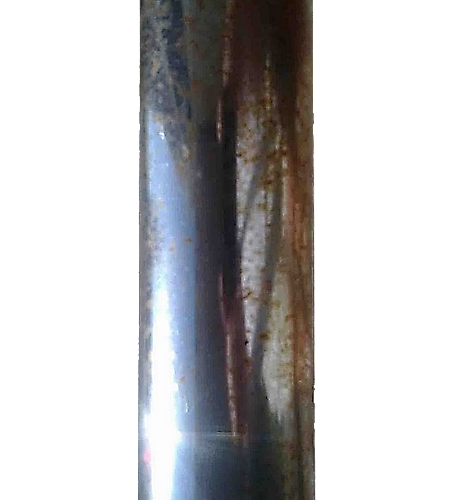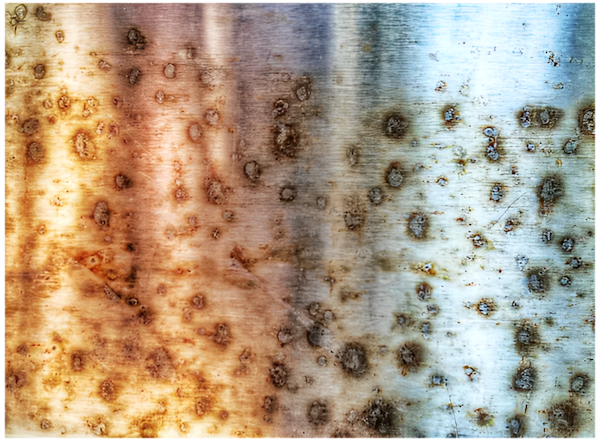The appearance of rust on stainless steel products baffles many people. If this material is called "stainless steel", then why can stainless steel oxidize, darken, blacken and rust? In fact, if the production technology is violated or the operating rules are violated, rust can appear even on high-quality stainless steel.
Very often our clients confuse or put in the same row "corrosion" and "rusting" of stainless steel. But this is not entirely correct. Let's figure out what the difference is:
Corrosion of metals
"- spontaneous destruction of metals and alloys, as well as other substances as a result of chemical, electrochemical or physicochemical interaction with the environment."
The main types of corrosion according to their mechanism include chemical, electrochemical, and biological.
Also corrosion can be divided into general and local:General (or uneven) corrosion"- is a process that occurs over the entire or any part of the metal surface at a rate of 0.1 - 0.5 mm/year. The result of general corrosion is the complete destruction of the metal surface or any part of its surface. In addition, the depth of corrosion penetration in some areas may be somewhat greater than in others."Localized (local) corrosion"- occurs in the form of spots, ulcers, dots. It can be selective, intercrystalline (intercrystalline), transcrystalline. Local corrosion also includes corrosion cracking. The consequence of local corrosion is the destruction of metal in depth until through holes appear, while neighboring areas may be practically unaffected by corrosion."
Rust (Rusting)
"- is a general term for the corrosion of elemental iron and its alloys such as stainless steel. In colloquial usage, the word is applied to the red oxides formed when iron reacts with oxygen in the presence of water or moist air."
Rust is the result of the corrosion process. So in short, we can say that rust is the result, corrosion is the process.
Now let's figure out why on products made of stainless steel, the chemical composition of which is confirmed by laboratory tests, rust still sometimes appears.
Reasons
 Stainless steels are resistant to corrosion because they contain chromium. It forms a very thin and impermeable layer of chromium oxide Cr2O3 on the surface of stainless steel, which prevents corrosion and makes stainless steel stainless. Corrosion (rust) forms on the surface stainless steel then, when the protective chromium oxide layer is damaged. This layer can be easily destroyed by acids and especially chlorine, fluorine and iodine compounds, as well as calcites. Even ordinary rainwater is dangerous for stainless steel because raindrops always contain a small amount of carbonic acid (H2CO3), iron and other impurities. This is especially common in industrial regions where the metallurgical, coal mining and oil and gas industries dominate. In addition, the oxide layer is negatively affected by various road anti-icing reagents that treat roads in winter, and the presence of a high content of calcites in the air, for example: construction dust containing lime, cement and similar materials. During rain, construction dust mixes with water, which as a result has a strongly alkaline reaction, and if such water hits the stainless steel surface in high concentrations, it can cause a violation of the oxide film and the appearance of a gray or white coating and even rust. Therefore, we do not recommend installing stainless steel products (railings, handrails, etc.) on sites where construction has not yet been completed.
Stainless steels are resistant to corrosion because they contain chromium. It forms a very thin and impermeable layer of chromium oxide Cr2O3 on the surface of stainless steel, which prevents corrosion and makes stainless steel stainless. Corrosion (rust) forms on the surface stainless steel then, when the protective chromium oxide layer is damaged. This layer can be easily destroyed by acids and especially chlorine, fluorine and iodine compounds, as well as calcites. Even ordinary rainwater is dangerous for stainless steel because raindrops always contain a small amount of carbonic acid (H2CO3), iron and other impurities. This is especially common in industrial regions where the metallurgical, coal mining and oil and gas industries dominate. In addition, the oxide layer is negatively affected by various road anti-icing reagents that treat roads in winter, and the presence of a high content of calcites in the air, for example: construction dust containing lime, cement and similar materials. During rain, construction dust mixes with water, which as a result has a strongly alkaline reaction, and if such water hits the stainless steel surface in high concentrations, it can cause a violation of the oxide film and the appearance of a gray or white coating and even rust. Therefore, we do not recommend installing stainless steel products (railings, handrails, etc.) on sites where construction has not yet been completed.
As a result, it can be concluded that the appearance of rust on the surfaces of stainless steel products can be affected by an aggressive external environment and improper care using unsuitable cleaning agents.
In regions with sea air, we recommend using stainless steel railings of at least AISI 304 - AISI 316 grades.
